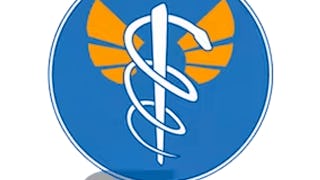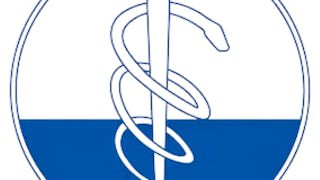In this course, you will get a thorough introduction to the emergency medical services system, and learn the foundation components to how it works as a whole. You will also learn the nuts and bolts of becoming a healthcare provider, and gain some basic knowledge about the human body. By the end of the course, you will be able to 1) understand the history and components of the EMS system, 2) speak the language of medicine with basic medical terminology, as well as have an understanding of basic human anatomy, 3) understand the different types of communications and how they are specific to EMS, 4) take vital signs and master the normal from the abnormal, and 5) master personal and scene safety, and begin the process of patient assessment.

Enjoy unlimited growth with a year of Coursera Plus for $199 (regularly $399). Save now.

EMT Foundations
This course is part of Become an EMT Specialization



Instructors: Angela Wright, MD
59,448 already enrolled
Included with
(1,132 reviews)
Skills you'll gain
- Personal protective equipment
- Emergency Medicine
- Emergency Medical Services
- Medical Terminology
- Anatomy
- Medical History Documentation
- Technical Communication
- Vital Signs
- Clinical Assessment
- Health Assessment
- Patient Positioning
- Occupational Health
- Health Systems
- Basic Patient Care
- Stress Management
- Patient Evaluation
- Patient Communication
Details to know

Add to your LinkedIn profile
7 assignments
See how employees at top companies are mastering in-demand skills

Build your subject-matter expertise
- Learn new concepts from industry experts
- Gain a foundational understanding of a subject or tool
- Develop job-relevant skills with hands-on projects
- Earn a shareable career certificate

There are 5 modules in this course
In this module, you will learn about the nuts and bolts of the emergency medical services system. We will cover some brief history of EMS, as well as breakdown the different components of the system. There will be discussion about some of the medical and legal issues that are persistent in the practice of prehospital medicine. We will also address workplace safety and provider wellness, because you cannot take care of other people unless you are learning to take care of yourself!
What's included
8 videos8 readings2 assignments
In this module, we will learn a new language. This module will cover basic medical terminology and some tips and tricks for “talking the talk.” This is also where we will cover the basics of anatomy of the human body! We will teach you the basics of human anatomy of the musculoskeletal, cardiovascular, pulmonary, abdominal, neurologic and endocrine system.
What's included
11 videos2 readings1 assignment
Essential to emergency medical services is communication. This module will discuss the various parts of the job that require communication and the different strategies to employ clear and concise communication. You will learn about the SBAR method of hand off reports, learn how to successfully communicate with patients, and we will cover some pearls and pitfalls to communicating within the EMS system.
What's included
10 videos3 readings1 assignment
Here we will cover vital signs, and learn about why they are vital! We will be teaching you how to take a blood pressure, respiratory rate, pulse, and assess a patient’s skin. We will also learn about taking a history during a patient encounter, and learn some standard approaches to this including the OPQRST and AMPLE templates of history taking.
What's included
10 videos5 readings1 assignment
In this last module, we will be discussing some bread and butter components of EMS. The first is scene safety and assessment of a scene. Then we will cover the complete assessment of a medical patient, and a trauma patient, using the national registry as our guideline. By the end of this, you will know how to communicate with patients and how to perform a thorough assessment of any patient you may encounter.
What's included
14 videos3 readings2 assignments
Earn a career certificate
Add this credential to your LinkedIn profile, resume, or CV. Share it on social media and in your performance review.
Instructors


Offered by
Explore more from Patient Care
 Status: Free Trial
Status: Free TrialMedCerts
 Status: Free Trial
Status: Free TrialUniversity of Colorado System
 Status: Free Trial
Status: Free TrialUniversity of Colorado System
 Status: Preview
Status: PreviewUniversidades Anáhuac
Why people choose Coursera for their career




Learner reviews
1,132 reviews
- 5 stars
84.28%
- 4 stars
11.65%
- 3 stars
2.82%
- 2 stars
0.52%
- 1 star
0.70%
Showing 3 of 1132
Reviewed on Aug 4, 2020
The course was given in a really friendly maner, with a lot of content (both external and given). They tought the basics very easily to someone that dind´t know anything
Reviewed on Dec 31, 2021
It was beyond my expectation....the teaching staff is really amazing .....am so greatful that i have this course .......i cant wait to take another course.....thank you so much!!!!!!
Reviewed on Dec 27, 2019
Very thorough debrief of basic skills needed before indulging into the course further. While also providing the necessary tools and vocabulary to help the learner become successful.
Frequently asked questions
IMPORTANT NOTICE: Current “Become an EMT” Specialization No Longer NREMT Eligible
Effective immediately, the current version of the “Become an EMT” specialization does NOT meet the National Registry of Emergency Medical Technicians (NREMT) certification requirements and cannot be used to qualify for NREMT examination.
Why This Change?
The current specialization no longer aligns with the new certification standards implemented by the NREMT in 2024. While the existing “Become an EMT” specialization remains valuable for those interested in learning about emergency medical services, it cannot be used for NREMT certification purposes.
New NREMT-Eligible Course Coming Spring 2026
A completely updated “Become an EMT” specialization that will meet all current NREMT requirements will be available on Coursera in spring 2026.
Requirements for NREMT Certification with New Course:
1. Successful completion of the online course content
AND
2. Successful completion of a hands-on skills course from a recognized EMT training center
Both components must be completed to be eligible for the NREMT examination and certification.
Currently Enrolled Learners
If you are currently enrolled in the “Become an EMT” specialization and need NREMT certification we suggest pausing your participation until the new specialization launches in spring 2026. What you have learned will help you through the new course more quickly and easily. However, partial completion of the existing course will not translate to partial completion of the new course.
Send questions to: uchmedic@uchealth.org.
Prospective Learners
If you are considering enrollment in the “Become an EMT” specialization:
• The current version of the specialization is notsuitable for NREMT certification
• The recommendation is to wait for the new NREMT-eligible version launching in spring 2026
The current course is valuable for:
• General EMS education and knowledge
• Career exploration in emergency medical services
• Continuing education for current healthcare professionals
Send questions to:uchmedic@uchealth.org.
To access the course materials, assignments and to earn a Certificate, you will need to purchase the Certificate experience when you enroll in a course. You can try a Free Trial instead, or apply for Financial Aid. The course may offer 'Full Course, No Certificate' instead. This option lets you see all course materials, submit required assessments, and get a final grade. This also means that you will not be able to purchase a Certificate experience.
When you enroll in the course, you get access to all of the courses in the Specialization, and you earn a certificate when you complete the work. Your electronic Certificate will be added to your Accomplishments page - from there, you can print your Certificate or add it to your LinkedIn profile.
More questions
Financial aid available,






